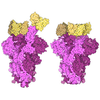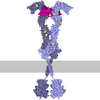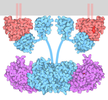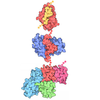+ データを開く
データを開く
- 基本情報
基本情報
| 登録情報 | データベース: PDB / ID: 8vqd | ||||||
|---|---|---|---|---|---|---|---|
| タイトル | HER2 S310F in complex with TL1 Fab | ||||||
 要素 要素 |
| ||||||
 キーワード キーワード | SIGNALING PROTEIN / HER2 / Fab / Tyrosine kinase receptor | ||||||
| 機能・相同性 |  機能・相同性情報 機能・相同性情報negative regulation of immature T cell proliferation in thymus / ERBB3:ERBB2 complex / ERBB2-ERBB4 signaling pathway / GRB7 events in ERBB2 signaling / immature T cell proliferation in thymus / RNA polymerase I core binding / semaphorin receptor complex / regulation of microtubule-based process / ErbB-3 class receptor binding / motor neuron axon guidance ...negative regulation of immature T cell proliferation in thymus / ERBB3:ERBB2 complex / ERBB2-ERBB4 signaling pathway / GRB7 events in ERBB2 signaling / immature T cell proliferation in thymus / RNA polymerase I core binding / semaphorin receptor complex / regulation of microtubule-based process / ErbB-3 class receptor binding / motor neuron axon guidance / Sema4D induced cell migration and growth-cone collapse / PLCG1 events in ERBB2 signaling / ERBB2-EGFR signaling pathway / ERBB2 Activates PTK6 Signaling / neurotransmitter receptor localization to postsynaptic specialization membrane / enzyme-linked receptor protein signaling pathway / neuromuscular junction development / ERBB2-ERBB3 signaling pathway / positive regulation of Rho protein signal transduction / Drug-mediated inhibition of ERBB2 signaling / Resistance of ERBB2 KD mutants to trastuzumab / Resistance of ERBB2 KD mutants to sapitinib / Resistance of ERBB2 KD mutants to tesevatinib / Resistance of ERBB2 KD mutants to neratinib / Resistance of ERBB2 KD mutants to osimertinib / Resistance of ERBB2 KD mutants to afatinib / Resistance of ERBB2 KD mutants to AEE788 / Resistance of ERBB2 KD mutants to lapatinib / Drug resistance in ERBB2 TMD/JMD mutants / positive regulation of transcription by RNA polymerase I / positive regulation of MAP kinase activity / ERBB2 Regulates Cell Motility / semaphorin-plexin signaling pathway / oligodendrocyte differentiation / PI3K events in ERBB2 signaling / positive regulation of protein targeting to membrane / regulation of angiogenesis / regulation of ERK1 and ERK2 cascade / Schwann cell development / Downregulation of ERBB2:ERBB3 signaling / coreceptor activity / Signaling by ERBB2 / TFAP2 (AP-2) family regulates transcription of growth factors and their receptors / myelination / transmembrane receptor protein tyrosine kinase activity / GRB2 events in ERBB2 signaling / positive regulation of cell adhesion / SHC1 events in ERBB2 signaling / cell surface receptor protein tyrosine kinase signaling pathway / basal plasma membrane / Constitutive Signaling by Overexpressed ERBB2 / cellular response to epidermal growth factor stimulus / peptidyl-tyrosine phosphorylation / positive regulation of translation / positive regulation of epithelial cell proliferation / neuromuscular junction / phosphatidylinositol 3-kinase/protein kinase B signal transduction / wound healing / Signaling by ERBB2 TMD/JMD mutants / Downregulation of ERBB2 signaling / Signaling by ERBB2 ECD mutants / receptor protein-tyrosine kinase / Signaling by ERBB2 KD Mutants / receptor tyrosine kinase binding / cellular response to growth factor stimulus / ruffle membrane / epidermal growth factor receptor signaling pathway / neuron differentiation / Constitutive Signaling by Aberrant PI3K in Cancer / transmembrane signaling receptor activity / PIP3 activates AKT signaling / myelin sheath / heart development / presynaptic membrane / RAF/MAP kinase cascade / PI5P, PP2A and IER3 Regulate PI3K/AKT Signaling / positive regulation of cell growth / protein tyrosine kinase activity / basolateral plasma membrane / early endosome / cell surface receptor signaling pathway / endosome membrane / cell population proliferation / protein phosphorylation / receptor complex / positive regulation of MAPK cascade / intracellular signal transduction / apical plasma membrane / protein heterodimerization activity / signaling receptor binding / negative regulation of apoptotic process / perinuclear region of cytoplasm / signal transduction / nucleoplasm / ATP binding / identical protein binding / nucleus / membrane / plasma membrane / cytosol 類似検索 - 分子機能 | ||||||
| 生物種 |  Homo sapiens (ヒト) Homo sapiens (ヒト) | ||||||
| 手法 | 電子顕微鏡法 / 単粒子再構成法 / クライオ電子顕微鏡法 / 解像度: 2.61 Å | ||||||
 データ登録者 データ登録者 | Bang, I. / Koide, S. | ||||||
| 資金援助 | 1件
| ||||||
 引用 引用 |  ジャーナル: Nat Chem Biol / 年: 2025 ジャーナル: Nat Chem Biol / 年: 2025タイトル: Selective targeting of oncogenic hotspot mutations of the HER2 extracellular domain. 著者: Injin Bang / Takamitsu Hattori / Nadia Leloup / Alexis Corrado / Atekana Nyamaa / Akiko Koide / Ken Geles / Elizabeth Buck / Shohei Koide /  要旨: Oncogenic mutations in the extracellular domain (ECD) of cell-surface receptors could serve as tumor-specific antigens that are accessible to antibody therapeutics. Such mutations have been ...Oncogenic mutations in the extracellular domain (ECD) of cell-surface receptors could serve as tumor-specific antigens that are accessible to antibody therapeutics. Such mutations have been identified in receptor tyrosine kinases including HER2. However, it is challenging to selectively target a point mutant, while sparing the wild-type protein. Here we developed antibodies selective to HER2 S310F and S310Y, the two most common oncogenic mutations in the HER2 ECD, via combinatorial library screening and structure-guided design. Cryogenic-electron microscopy structures of the HER2 S310F homodimer and an antibody bound to HER2 S310F revealed that these antibodies recognize the mutations in a manner that mimics the dimerization arm of HER2 and thus inhibit HER2 dimerization. These antibodies as T cell engagers selectively killed a HER2 S310F-driven cancer cell line in vitro, and in vivo as a xenograft. These results validate HER2 ECD mutations as actionable therapeutic targets and offer promising candidates toward clinical development. | ||||||
| 履歴 |
|
- 構造の表示
構造の表示
| 構造ビューア | 分子:  Molmil Molmil Jmol/JSmol Jmol/JSmol |
|---|
- ダウンロードとリンク
ダウンロードとリンク
- ダウンロード
ダウンロード
| PDBx/mmCIF形式 |  8vqd.cif.gz 8vqd.cif.gz | 156.5 KB | 表示 |  PDBx/mmCIF形式 PDBx/mmCIF形式 |
|---|---|---|---|---|
| PDB形式 |  pdb8vqd.ent.gz pdb8vqd.ent.gz | 109.9 KB | 表示 |  PDB形式 PDB形式 |
| PDBx/mmJSON形式 |  8vqd.json.gz 8vqd.json.gz | ツリー表示 |  PDBx/mmJSON形式 PDBx/mmJSON形式 | |
| その他 |  その他のダウンロード その他のダウンロード |
-検証レポート
| 文書・要旨 |  8vqd_validation.pdf.gz 8vqd_validation.pdf.gz | 1.5 MB | 表示 |  wwPDB検証レポート wwPDB検証レポート |
|---|---|---|---|---|
| 文書・詳細版 |  8vqd_full_validation.pdf.gz 8vqd_full_validation.pdf.gz | 1.5 MB | 表示 | |
| XML形式データ |  8vqd_validation.xml.gz 8vqd_validation.xml.gz | 34.3 KB | 表示 | |
| CIF形式データ |  8vqd_validation.cif.gz 8vqd_validation.cif.gz | 49.4 KB | 表示 | |
| アーカイブディレクトリ |  https://data.pdbj.org/pub/pdb/validation_reports/vq/8vqd https://data.pdbj.org/pub/pdb/validation_reports/vq/8vqd ftp://data.pdbj.org/pub/pdb/validation_reports/vq/8vqd ftp://data.pdbj.org/pub/pdb/validation_reports/vq/8vqd | HTTPS FTP |
-関連構造データ
| 関連構造データ |  43439MC 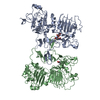 8vqeC C: 同じ文献を引用 ( M: このデータのモデリングに利用したマップデータ |
|---|---|
| 類似構造データ | 類似検索 - 機能・相同性  F&H 検索 F&H 検索 |
- リンク
リンク
- 集合体
集合体
| 登録構造単位 | 
|
|---|---|
| 1 |
|
- 要素
要素
| #1: タンパク質 | 分子量: 99261.641 Da / 分子数: 1 / 変異: S310F / 由来タイプ: 組換発現 / 由来: (組換発現)  Homo sapiens (ヒト) / 遺伝子: ERBB2, HER2, MLN19, NEU, NGL / 発現宿主: Homo sapiens (ヒト) / 遺伝子: ERBB2, HER2, MLN19, NEU, NGL / 発現宿主:  Homo sapiens (ヒト) / 参照: UniProt: P04626, receptor protein-tyrosine kinase Homo sapiens (ヒト) / 参照: UniProt: P04626, receptor protein-tyrosine kinase |
|---|---|
| #2: 抗体 | 分子量: 27512.574 Da / 分子数: 1 / 由来タイプ: 組換発現 / 由来: (組換発現)  Homo sapiens (ヒト) / 発現宿主: Homo sapiens (ヒト) / 発現宿主:  |
| #3: 抗体 | 分子量: 23339.900 Da / 分子数: 1 / 由来タイプ: 組換発現 / 由来: (組換発現)  Homo sapiens (ヒト) / 発現宿主: Homo sapiens (ヒト) / 発現宿主:  |
| #4: 多糖 | 2-acetamido-2-deoxy-beta-D-glucopyranose-(1-4)-2-acetamido-2-deoxy-beta-D-glucopyranose |
| 研究の焦点であるリガンドがあるか | N |
| Has protein modification | Y |
-実験情報
-実験
| 実験 | 手法: 電子顕微鏡法 |
|---|---|
| EM実験 | 試料の集合状態: PARTICLE / 3次元再構成法: 単粒子再構成法 |
- 試料調製
試料調製
| 構成要素 | 名称: HER2 S310F in complex with TL1 Fab / タイプ: COMPLEX 詳細: Fab that only binds to HER2 S310F/Y but not to WT is in complex with HER2 S310F Entity ID: #1-#3 / 由来: RECOMBINANT | ||||||||||||||||||||
|---|---|---|---|---|---|---|---|---|---|---|---|---|---|---|---|---|---|---|---|---|---|
| 分子量 | 値: 150 kDa/nm / 実験値: NO | ||||||||||||||||||||
| 由来(天然) | 生物種:  Homo sapiens (ヒト) Homo sapiens (ヒト) | ||||||||||||||||||||
| 由来(組換発現) | 生物種:  Homo sapiens (ヒト) Homo sapiens (ヒト) | ||||||||||||||||||||
| 緩衝液 | pH: 7.5 詳細: 20mM Tris, 150mM NaCl, 0.7mM fluorinated octyl maltoside | ||||||||||||||||||||
| 緩衝液成分 |
| ||||||||||||||||||||
| 試料 | 濃度: 1.4 mg/ml / 包埋: NO / シャドウイング: NO / 染色: NO / 凍結: YES 詳細: This sample was was eluted as a monodisperse peak with gel filtration | ||||||||||||||||||||
| 試料支持 | 詳細: The grid was coated with goldfoil prior and discharged with current at 15mA for 25s, held for 10s. グリッドの材料: COPPER / グリッドのサイズ: 300 divisions/in. / グリッドのタイプ: Quantifoil R0.6/1 | ||||||||||||||||||||
| 急速凍結 | 装置: FEI VITROBOT MARK IV / 凍結剤: ETHANE / 湿度: 95 % / 凍結前の試料温度: 277.15 K 詳細: Vitrification carried out with blot force 5, blot time 4 s |
- 電子顕微鏡撮影
電子顕微鏡撮影
| 実験機器 |  モデル: Titan Krios / 画像提供: FEI Company |
|---|---|
| 顕微鏡 | モデル: FEI TITAN KRIOS |
| 電子銃 | 電子線源:  FIELD EMISSION GUN / 加速電圧: 300 kV / 照射モード: FLOOD BEAM FIELD EMISSION GUN / 加速電圧: 300 kV / 照射モード: FLOOD BEAM |
| 電子レンズ | モード: BRIGHT FIELD / 倍率(公称値): 105000 X / 最大 デフォーカス(公称値): 2400 nm / 最小 デフォーカス(公称値): 900 nm / Cs: 2.7 mm |
| 撮影 | 平均露光時間: 2 sec. / 電子線照射量: 57.43 e/Å2 フィルム・検出器のモデル: GATAN K3 BIOQUANTUM (6k x 4k) 撮影したグリッド数: 1 / 実像数: 8985 |
| 電子光学装置 | エネルギーフィルター名称: GIF Bioquantum / エネルギーフィルタースリット幅: 20 eV |
- 解析
解析
| EMソフトウェア |
| ||||||||||||||||||||||||||||||||||||||||||||||||||
|---|---|---|---|---|---|---|---|---|---|---|---|---|---|---|---|---|---|---|---|---|---|---|---|---|---|---|---|---|---|---|---|---|---|---|---|---|---|---|---|---|---|---|---|---|---|---|---|---|---|---|---|
| CTF補正 | タイプ: PHASE FLIPPING AND AMPLITUDE CORRECTION | ||||||||||||||||||||||||||||||||||||||||||||||||||
| 3次元再構成 | 解像度: 2.61 Å / 解像度の算出法: FSC 0.143 CUT-OFF / 粒子像の数: 161060 / 対称性のタイプ: POINT | ||||||||||||||||||||||||||||||||||||||||||||||||||
| 原子モデル構築 | プロトコル: FLEXIBLE FIT / 空間: REAL | ||||||||||||||||||||||||||||||||||||||||||||||||||
| 原子モデル構築 | 3D fitting-ID: 1
| ||||||||||||||||||||||||||||||||||||||||||||||||||
| 拘束条件 |
|
 ムービー
ムービー コントローラー
コントローラー




 PDBj
PDBj

